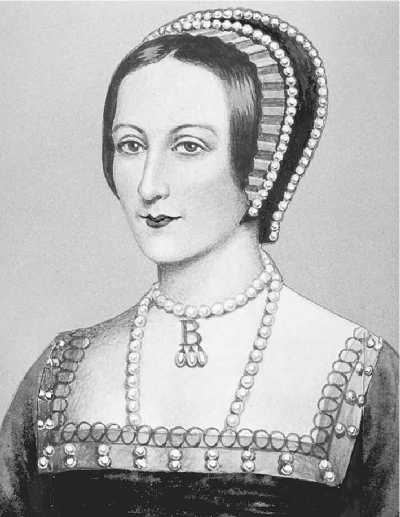Second wife of King Henry VIII of England, patron of religious reform activists, executed on the king’s orders
Anne Boleyn was born in 1507 to Elizabeth Howard, daughter of the second duke of Norfolk, and Sir Thomas Boleyn, future earl ofWilt-shire. Probably the eldest of their three children, Anne’s sister, Mary, became William Carey’s wife and Henry Vlll’s mistress, and her brother George, future Lord Rochford, joined Henry Vlll’s privy chamber. In 1513, Anne began studying French at the court of Margaret of Savoy, regent of the Netherlands. In 1514, she removed to France as maiden of honor to Mary Tudor, who wed Louis XII. After his death, Anne attended Claude, Francis I’s consort, and his sister Margaret d’Alencon. Anne became fluent in French and learned to sing, to play musical instruments, and to do needlework.
She entered the English court in 1521 but was soon expelled for contracting a secret betrothal with Lord Henry Percy. In 1526, when she returned as Catherine of Aragon’s maiden of honor, Henry was planning to end his marriage on the grounds that God was causing the

Anne Boleyn, second wife of King Henry VIII of Engand. Portrait by unknown artist. (Corel)
Death of his male infants to punish him for violating a Levitical law when he wed Catherine, his brother Arthur’s widow. After petitioning Pope Clement VII for an annulment, Henry wrote love letters to Anne, who was absent from court in 1528, recovering from the sweating sickness and for other reasons. Seventeen of his letters are now at the Vatican. Despite Clement’s refusal to nullify his marriage, Henry wed Anne on 25 January 1533.
By authority of the Appeals Statute, Archbishop Thomas Cranmer invalidated Henry’s alliance with Catherine and then validated the one with Anne. She was crowned on 1 June and gave birth to Elizabeth on 7 September. As queen, she patronized evangelicals, supervised her royal chapel, and won rewards for her relatives, including the marriage of Mary Howard, daughter of the third duke of Norfolk, to Henry’s illegitimate son, Henry Fitzroy, duke of Richmond. Anne failed to accomplish her most important duty, for she was unable to give birth to a healthy son, suffering miscarriages in 1534 and 1536. Citing the dispatches of the Imperial ambassador, Eustace Chapuys, some writers claim that after she was delivered of a male fetus of perhaps three-and-one-half months in January 1536, Thomas Cromwell, the king’s principal minister, deserted her evangelical faction for the Catholic faction. He allegedly betrayed her because her support for the French alliance was preventing England’s rapprochement with Emperor Charles V, Catherine’s nephew. Cromwell subsequently manipulated Henry into executing Anne and marrying Jane Seymour. As no other evidence verifies this conspiracy theory, it is more likely that Cromwell was deceiving Cha-puys to prevent his learning that Anne’s fetus was deformed, a tragedy that contemporaries interpreted as God’s punishment for their parents’ sins, especially their sexual misconduct. Blaming Anne’s promiscuity for the deformity, Henry ordered her and her five apparent lovers incarcerated in the Tower of London. Just before her arrest on 2 May, Anne’s thoughts turned to Elizabeth, and she asked Matthew Parker, future archbishop of Canterbury, to monitor her well-being.
The indictments accused Anne of witchlike, lecherous behavior, of enticing the five men with French kisses to perform sexual acts with her. The accused were her brother, George Boleyn, Lord Rochford, Sir Francis Weston, William Norris, William Brereton, and Mark Smeaton, all of whom were executed. No effort was made to ensure that she was with the men at the time and place stated in the indictments. For instance, they claimed she met Rochford on 5 December 1535 at Westminster when she was with Henry at Windsor. Also arrested but released were Richard Page and Thomas Wyatt, who may have composed sonnets to her. These accusations of witchlike behavior led Nicholas Sander and other Catholic writers to describe her as physically disfigured. She did not, as they claimed, have a sixth finger or a wen on her throat.
At the Tower, she confessed to rejecting Weston’s and Norris’s attentions. Incredibly, some writers have interpreted these admissions as proof that she was actually the men’s courtly lover. For spiritual comfort, she asked her jailors to place the sacrament in a closet near her chamber. At her trial on 15 May, although she swore that she was faithful to her husband, she was convicted of treason. Two days later, Cranmer pronounced her marriage to Henry invalid, perhaps citing as grounds her alleged witchlike powers. At her execution on 19 May, she prayed to God to give the king a long reign and asked witnesses to think the best of her. After the Calais executioner beheaded her with one stroke of a special sword, she was buried at St. Peter ad Vincula at the Tower.
Retha Warnicke
See also Power, Politics, and Women; Religious Reform and Women; Witchcraft, Witches, and Witch-Hunting.
Bibliography
Ives, Eric. Anne Boleyn. Oxford: Blackwell, 1986.
Warnicke, Retha M. The Rise and Fall of Anne Boleyn: Family Politics at the Court of Henry VIII. Cambridge, UK: Cambridge University Press, 1989.




 World History
World History









